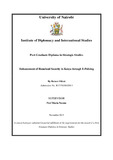| dc.description.abstract | The key objective of this research study is to establish how the Internet and web technologies can be used in the fight against crime; assist the homeland security to reach a large population; open up communication for the public to assist homeland security in investigations; increase homeland security partnership with the community; and cut policing costs. The assumption is that the use of the Internet and web technologies in assisting the homeland security to reach a large population and open up communication for the public to assist homeland security in investigations will improve the fight against crime by 50%.
Three methods which include questionnaire, interview and literature search are used in collecting the required data. Data analysis is conducted using Microsoft Excel and Statistical Package for Social Sciences (SPSS). Some of the functions found in Excel and SPSS which include frequency counts, weighted mean, sub-totals and totals, and pivot tables are used to generate the required charts for easier interpretation.
The implementation of e-policing in administering police operations by Kenya Police Service still remains a far-fetched dream and great effort need to be put in order to achieve e-policing status fully. E-policing is more than just having a police web site. It is about putting the required applications and infrastructure in place in order to provide police services electronically online. E-policing system is a supplementary of the traditional way of policing, which includes telephone system and face-to-face system in provision of police services to the public. It cannot completely substitute these traditional systems.
The Kenya Police Web site does not have all important features/functions that are needed for e-policing which are found in most of the police web sites in the UK police authorities. These features include crime and witness appeal, ability to record serial numbers of property and online subscription for information on police operations.
There is need to implement an e-policing strategy for the Kenya Police Service. This will help identify weakness and problems for correction and modification for future e-policing projects. Best methods for providing police services to the general public in Kenya electronically online, whether just to put information on a web site or interact fully with the police will also be established. | en_US |

